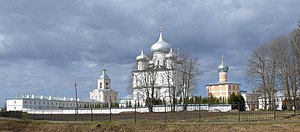Khutyn Monastery

58°35′14″N 31°23′42″E / 58.58722°N 31.39500°E Khutyn Monastery of Saviour's Transfiguration and of St. Varlaam (
The
According to

Ivan's son
The annex of St. Gabriel, added to the cathedral in 1646, received its present name after the poet
The vicar of the Novgorodian diocese was, at times, titled Archbishop of Khutyn and lived in the Khutyn Monastery. For example, Archbishop Aleksei (Simansky) was Archbishop of Khutyn from 1926-1932. He administered the diocese while Metropolitan Arsenii was imprisoned and in exile in Central Asia. Aleksei was briefly Archbishop of Novgorod (in 1933) and then Patriarch of Moscow and All Rus' (1945-1970).
During the first decades of Soviet rule the monastery housed a lunatic asylum. It was later a vacation home or hostel for visitors to the area. It was restored to the church in 1993. While for most of its history it was a male monastery, it is currently a women's convent.
References
- ^ Its name is perhaps derived from the Russian "khudoi" (худой) meaning "ill, bad, or poor," possibly suggesting that the village or the region around it was an evil place, or a poor area among the marshes and near the river.
- ^ Arsenii Nikolaevich Nasonov, Novgorodskaia Pervaia Letopis' starshego i mladshego izvodov (Moscow and Leningrad, Akademii Nauk SSSR, 1950), 40. 231.
- ^ Zhitie prepodobnogo i bogonosnogo otsa nashego Varlaama Khutynskogo novgoodskogo chudotvortsa (Moscow: Pravoslavnoe bratstvo “Sporupishchy greshnykh,” 1996), 20-21.
- ^ Novgorodskaia tretaia letopis, in Polnoe Sobranie Russkikh Letopisei, vol 3, p. 247.
